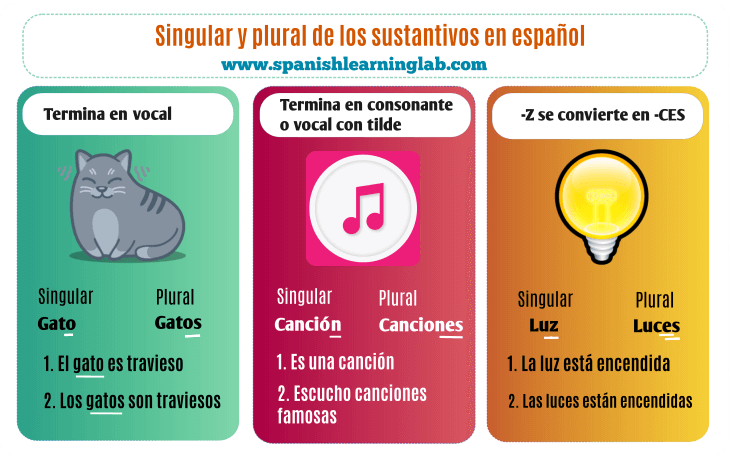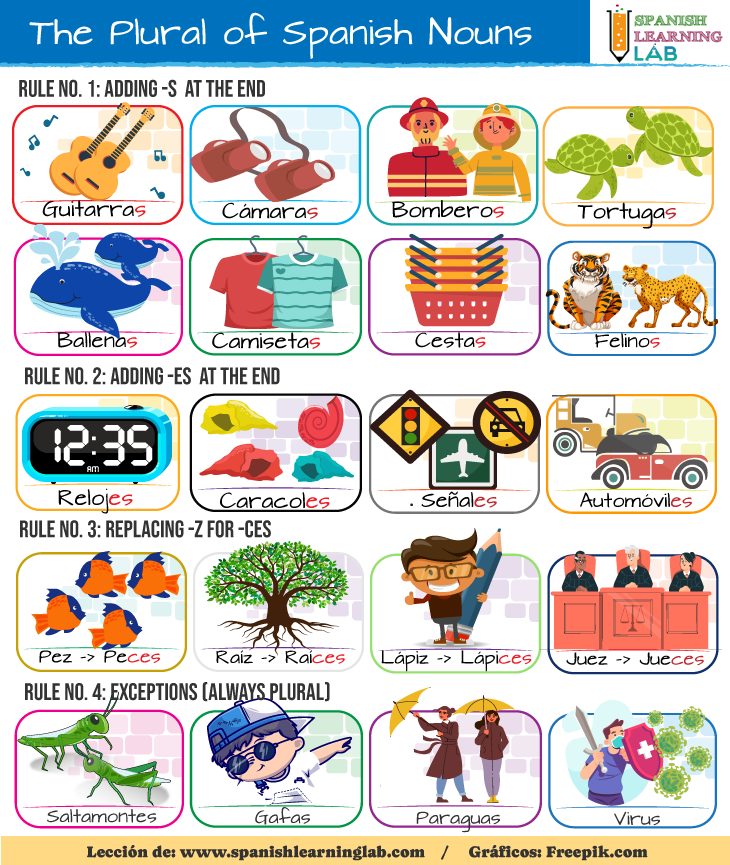Most Spanish nouns, as well as many other words in the language, have a singular and a plural form, besides having a masculine or feminine gender and fall into a given category. In this grammar lesson, we will cover the basic rules for the plural of Spanish nouns and will apply these rules in real sentences so that you understand how to make words plural and use them in real contexts. There is a nice quiz at the end of the lesson for you to check your comprehension of the grammar structures. Let’s start…
Introductory video: Singular and Plural Nouns in Spanish
There is so much to talk about the plural of nouns in Spanish, which is why we have produced a short video explaining the rules on this topic in detail and presenting many examples of word transformations from singular to plural in Spanish. Turn on captions if you need them.
What is the plural of Spanish nouns? – El plural y el singular
The plural of Spanish nouns or “El plural” refers to a basic transformation of words from singular to plural form in order to talk about several objects, instead of a single one. In grammar terms, this property is called NÚMERO GRAMATICAL or grammatical number. Words in the language usually have a singular (cuaderno) or plural form (cuadernos), which is easy to form following some simple rules that we will discuss shortly.
The singular of nouns is called EL SINGULAR, whereas the plural of Spanish nouns is called EL PLURAL. Here is a picture with three examples of nouns changing from singular to plural form. We will develop on these rules throughout the rest of the lesson.

The basic rules for making nouns plural in Spanish
Rule No.1: Adding -S at the end of the word
The first rule for the plural of Spanish nouns says that we add the letter -S at the end of a word when it ends with a vowel without TILDE such as the words “CASA” and “MESA”. Notice that both CASA and MESA do not need TILDE at all over the last vowel. For words ending in “É” like BEBÉ, we still add the letter -S as this is an exception to the rule. Here are some examples of sentences showing how to make Spanish nouns plural by adding -S. Click on Play to listen to the examples.
|
Casa – Hay tres casas pequeñas.
There are three small houses
|
|
Mesa – ¿Podrías limpiar las mesas?
Could you clean the tables?
|
|
Bebé – Esos son mis bebés
They are my babies
|
|
Cama – Ellos venden camas
They sell beds
|
Rule No.2: Adding -ES at the end of the word
The second rule to make Spanish nouns plural says that we add the letters -ES when the word ends in a consonant. This rule applies to nouns like “TELEVISOR” or “PAPEL” and also to those ending in a vowel with TILDE (á, í, ó, ú) other than É like “Bebé”. Here are some examples of sentences using plural nouns in Spanish with a -ES ending:
|
Televisor – Compramos dos televisores
We bought two televisions
|
|
Canción – El álbum tiene 12 canciones
The album has 12 songs
|
|
Rubí – Los rubíes son caros
Rubies are expensive
|
|
Ratón – Hay ratones en la casa
They are mice in the house
|
Rule No.3: Replacing -Z for -CES
As an orthographic rule, when a word ends in the consonant –Z, we replace the -Z for -CES. Some common Spanish nouns ending in -Z are: actriz (actress), audaz (bold), avestruz (ostrich), feliz (happy), pez (fish) and voz (voice). Here are some examples of sentences with plural nouns in Spanish ending in -Z. Click on PLAY to listen to the examples.
|
Luz – Hay varias luces encendidas
There are several lights on
|
|
Voz – Sus voces son hermosas
Their voices are beautiful
|
|
Cruz – Hay varias cruces en la iglesia
There are several crosses in the church
|
Rule No.4: Exceptions – Words with no plural in Spanish
There are some words that do not have a plural form because it would sound odd, including the ones that end in the consonants –S and -X. Some words that do not have a plural form are: Tórax, Crisis, Paraguas (umbrella), Saltamontes (crickets) and Nada (nothing). Some of these words may have a singular form like “Saltamonte”, but we should use them in plural form most of the time.
|
Tórax – El tórax es una parte del cuerpo
The thorax is a part of the body
|
|
Nada – No hay nada aquí
There is nothing here
|
|
Lunes – Los lunes son días ocupados
Monday is a busy day.
|
Wrapping Up!
Finally, here is a summary of the rules for the plural of Spanish nouns through this set of beautiful images illustrating many common and useful nouns for everyday conversations. Don’t forget to practice with the exercises in the lesson’s interactive quiz. ¡Hasta la próxima!

- Rule No. 1: Las tortugas están nadando hacia la costa. (The turtles are swimming towards the coast.)
- Rule No. 2: Esos automóviles están en venta. (Those cars are for sale.)
- Rule No. 3: Olvidé mis lápices sobre la mesa. (I forgot my pencils on the table)
- Rule No. 4: Las vacunas ayudan a combatir los virus. (Vaccines help fight viruses.)
Related Spanish Worksheets:
- Classifying Nouns in Spanish – PDF Worksheet
- Singular and Plural Nouns in Spanish – PDF Worksheet
- Spanish Nouns Gender and Number – PDF Worksheet
- Indefinite Articles in Spanish – PDF Worksheet
- Definite Articles in Spanish – PDF Worksheet

“The last rule for the plural of Spanish nouns says that if a word has tilde (accent) over a certain vowel in singular form like the word LÁPIZ (pencil), then we must drop the tilde for the plural form of that noun and follow the previous rules so for a noun like LÁPIZ we would say LAPICES, and for a noun like EXÁMEN we would say EXAMENES.”
This is not true, the right forms are “lápices” and “exámenes”
Yes, you are totally correct. We’ll fix it right away. Thanks!